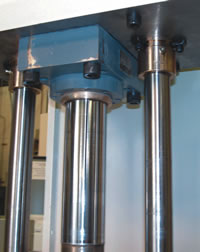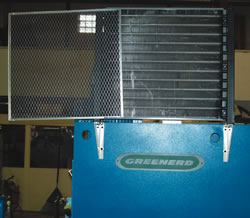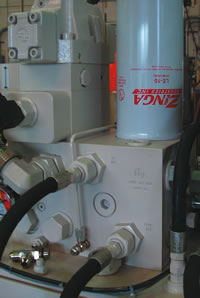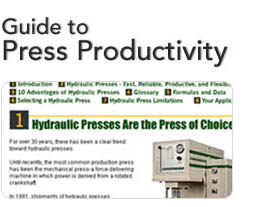| Daily and yearly checkups save time, money
Ask 10 stampers what preventive maintenance is, and you’ll probably get 10 different answers.
Why? Because not all presses require the same maintenance.
To keep all of your shop’s equipment in good working condition, try developing and implementing a written routine preventive maintenance schedule.
An Ounce of Prevention
Press operators play a big part in keeping the equipment running efficiently. Maintenance should address immediately strange noises, vibrations, or something that doesn’t look right. The sooner problems are detected and corrected, the better, which can often mean a less expensive fix.

Sometimes it’s the small preventive measures that keep a hydraulic press up and running. A daily maintenance check list should include the following:
- Check for oil leaks on all hydraulic lines. A small leak can turn into a big mess. Tighten leaky fittings and wipe off excess oil. Keeping a press clean will help pinpoint new leaks and keep the press running cooler.
- Check the oil level and, if necessary, top it off. Most presses have an oil tag listing the type of oil needed.
- Check for loose bolts around the tooling area. Some dies can cause press vibration and shock, which loosen bolts.
- Check lubrication on guided platens. Some bushings have fittings that should be greased to maintain a thin lubrication film over the rod. Do not overgrease because this causes dirt to accumulate, causing the bearing to wear prematurely.
Other bushings have a check valve-type fitting. These bushings have graphite impregnated into the bronze and require little maintenance. Mobil Viscolite® or a similar oil can be used, but only a small amount is needed to spread the graphite onto the rod. Never put grease into this type of bearing.

- Check the oil temperature. When the press has reached its normal operating temperature, check the oil temperature. It should be around 120 degrees F.
- Check the ram. A press’s ram should be moist but not dripping oil (see Figure 1).
- Check light curtains. One way to do this is to break the beam while the ram is traveling down. The press should stop immediately. Breaking the beam on the upstroke might not stop the press. Refer to the owner’s manual for proper function.
Oil Maintenance
Besides performing daily maintenance, maintenance personnel should closely monitor a press’s oil health (see Figure 2). Similar to an automobile, a hydraulic press can’t run optimally on low or dirty oil.

Keeping a press’s oil in new condition is fairly easy to do. Dirt and heat are the principal enemies of a hydraulic press. Not maintaining the proper oil levels and quality will rapidly reduce the life of a machine.
The ideal operating temperature is approximately 120 degrees F, which can be maintained by air or water coolers. Probes are inserted into the oil reservoir, and its temperature is maintained with a thermostat. Air coolers use a radiator to separate the heat with an electric fan. Water coolers use water or gylcol.
The radiator should always be clean (see Figure 3). Its vanes tend to collect dirt and dust, which prevent the airflow from traveling at maximum capacity. Attaching an inexpensive filter such as one used in heating and air-conditioning units to the heat exchanger will help keep the unit clean.
Water-cooled systems work similarly, except water instead of air travels through the vanes. Three primary methods of cooling with water are city water, rooftop-mounted exchangers, and chillers. Running city water through an exchanger can be expensive and has a tendency to rust the exchanger. Also, many municipalities discourage using city water because of local water restrictions and codes. To inspect water-cooled heat exchangers, remove the end caps and check to make sure the passage is clear. Flush with cleaning solvent if necessary.
Rooftop-mounted units can collect dust and dirt, which may clog the exchanger and cause rust if there is no rust inhibitor in the water. Placing a filter in the water line removes most fine particles. Again, inspect this equipment yearly.

Water chillers are an efficient method to dissipate heat because the inlet temperature can be adjusted and antirusting agents can be added to the water. A yearly equipment inspection is recommended.
An oil sampling should be performed yearly. Hydraulic fluids should be sampled and tested to ensure contamination and fluid properties are within acceptable levels. This sampling shows how many different-sized particles are in the oil, if the oil has water in it, and the oil’s lubricity properties.
In most cases, it’s unnecessary to change the oil, but certain chemical additives may be needed to restore lubricity properties. A sampling also determines if oil filters are being changed at proper intervals and if the correct filtration micron level is being achieved (see Figure 4).
Simple hydraulic systems require code 10 filters. Code 10 filters have an ISO code range of 20/18/15. More complex systems with proportional or servo valves require code 03 filters. Code 03 filters have an ISO code range of 16/14/12.
Electrical Maintenance
Although modern electronics are reliable, they don’t last forever. Coils on valves normally have a life cycle of approximately 3 million strokes, and relays have a life cycle of about 1 million strokes. Replacing them before they fail eliminates or reduces hours of troubleshooting and downtime.
Installing an hour meter and a nonresettable cycle counter helps maintain accurate records and assists with scheduling maintenance. Control wiring should be checked annually to ensure all connections are tight and the wiring is in good condition. Loose wiring should be placed in wire ways or tied with wire ties (see Figure 5). All spare or unused wires should be capped off or removed. Any dust or dirt also should be removed from enclosures.

Keeping your hydraulic press clean helps keep it in good working order. Never put off a problem for the next person to report or repair. Preventive maintenance is a small price to pay to keep your press running. | 





















